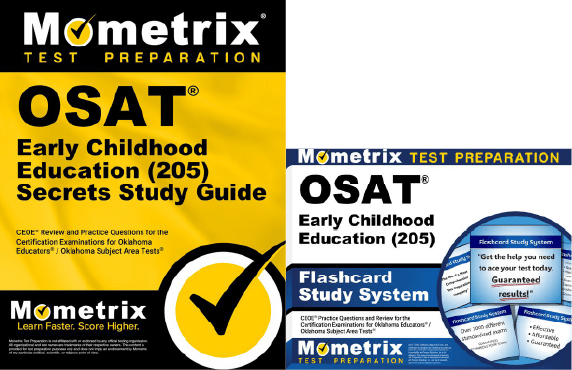If you need help studying for the OSAT Early Childhood Education test or just want some more information about what the test is like, you’ve come to the right place!
Click below to take a free OSAT Early Childhood Education practice test!
What’s on the Test?
First, let’s talk about the questions on the OSAT Early Childhood Education test. There are 81 questions in total, most being selected-response and one being constructed-response.
80 questions
Selected-response questions require you to select the correct answer from a list of options. Multiple-choice questions are the most common example, but you may also see true-or-false questions and “matching” questions, which ask you to match terms or concepts with their definitions.
Constructed-Response (CR)
1 question
The constructed-response question requires you to write your answer instead of selecting from a list of choices. Your response to this question is generally expected to be at least a few sentences, but you’ll be given specific details and instructions before you take the test.
The time limit for the exam is 4 hours. There aren’t any scheduled breaks, but you’re free to take restroom breaks as needed.
Let’s take a closer look at the different sections of the test.
1. Child Development, Language, and Learning
16% of the exam
- Early childhood development from birth through grade three
- Expressive and receptive language development
- Providing learning experiences that encourage children’s development of language and literacy skills
- Cognitive development of young children
2. The Learning Environment, Physical Development, and Assessment
21% of the exam
- Creating and managing a positive learning environment for children through grade three
- Using various types of instructional materials and resources to support young children’s learning
- Young children’s physical development
- Goals, types, benefits, and uses of assessments that support young children and their families
3. Learning across the Curriculum
34% of the exam
- Emergent literacy development
- Word identification strategies
- Using implicit and explicit instruction to promote knowledge and skills
- Promoting children’s reading comprehension, reading fluency, and vocabulary skills
- Writing processes
- Promoting young children’s writing skills
- Fundamental mathematics skills, concepts, and vocabulary
- Science and social studies skills and concepts
- The role of the arts in the development of young children
4. Professional Knowledge and Responsibilities
14% of the exam
- Building positive and collaborative relationships with families, professionals, and community agencies and organizations
- The roles and responsibilities of early childhood teachers
5. Analysis of Young Children’s Learning
15% of the exam
Then, you’ll be given specific instructions on what your written response should cover. Your finished response should be between 300 and 600 words.
How to Register
To register for the test, you’ll first need to contact the OSDE so they can ensure you’re eligible to take the exam. Then, you can create an account on the CEOE website. Once your account has been created, you can register to take the exam.
How the Exam is Scored
The OSAT Early Childhood Education test is scored using a scaled scoring method. Here’s how it works:
Scaled Scoring
For every question you answer correctly, you get one point added to your raw score. At the end of the test, your final raw score will be converted to a scaled score.
The reason your raw score is converted to a scaled score is because everyone that takes the test is given a slightly different set of questions. Since everyone has a different arrangement of questions, and because some questions are harder than others, converting your raw score to a scaled score ensures a more even playing field.
Retaking the Exam
If you don’t get the score you want on your first try, that’s okay! You can take the exam again after a mandatory 30-day waiting period.
FAQs
How many questions are on the OSAT Early Childhood Education exam?
The exam contains 81 questions.
What is the time limit for the OSAT Early Childhood Education exam?
The exam is timed at 4 hours.
What is the passing score for the OSAT Early Childhood Education exam?
You’ll need to get a final scaled score of at least 240 to pass.
How much does the OSAT Early Childhood Education exam cost?
The testing fee is $118.
OSAT, CEOE, Oklahoma Subject Area Tests, and Certification Examinations for Oklahoma Educators are trademarks of the Office of Educational Quality and Accountability and Pearson Education, Inc. or its affiliate(s). This page was developed by Mometrix Test Preparation. It was not developed in connection with Pearson Education, Inc., nor was it reviewed, approved or endorsed by these agencies.



 OSAT Study Guide
OSAT Study Guide OSAT Flashcards
OSAT Flashcards